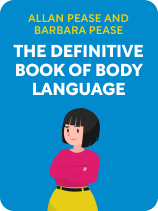

This article is an excerpt from the Shortform book guide to "The Definitive Book of Body Language" by Allan Pease and Barbara Pease. Shortform has the world's best summaries and analyses of books you should be reading.
Like this article? Sign up for a free trial here.
Want to know more about The Definitive Book of Body Language by Allan and Barbara Pease? Why is understanding body language so important?
In The Definitive Book of Body Language, Allan and Barbara Pease explain what lies behind the unspoken messages we convey through our body language. The book delves into the profound impact of body language on our interactions, emotions, and overall relationships with others.
Read on for a brief overview of The Definitive Book of Body Language by Allan and Barbara Pease.
The Definitive Book of Body Language Overview
In The Definitive Book of Body Language, Allan and Barbara Pease argue that body language plays a key role in shaping interactions between people. The authors explain that during verbal interactions, people pay more attention to the facial expressions, gestures, and postures they see than the words they hear. Therefore, understanding body language—both your own and that of others—can help you communicate more effectively.
Part 1: Why Body Language Matters
According to The Definitive Book of Body Language by Allan and Barbara Pease, there are three key principles of body language that underscore why it’s so important:
- Your body language both reflects and influences your emotions.
- Your body language influences how people feel about you and interpret your words.
- Awareness of your body language helps you control your emotions and the way others respond to you.
Let’s explore each of these principles.
Principle #1: Your Body Language Reflects and Influences Your Emotions
Allan and Barbara Pease argue in The Definitive Book of Body Language that your body language—your facial expressions, gestures, and posture—always reflects your emotions. They explain that there’s a strong physiological link between your emotions and your body language. This link is bidirectional: Your emotions trigger physiological responses that get reflected in your body language, and your body language, in turn, influences your emotions and physiological responses.
Principle #2: Your Body Language Influences How People Interpret Your Words
In addition to reflecting and influencing your emotions, your body language also influences the way others interpret your words. Allan and Barbara Pease explain that, during verbal interactions, people intuitively respond to each other based more on what they see than on what they hear. They suggest that your body language accounts for 60–80% of how others perceive you. This perception determines how they interpret and respond to your words.
The authors argue that people are more likely to respond positively to your words when they trust you, and the degree to which people trust you hinges on how well your words and your body language align:
When your body language aligns with your words, people trust you because they feel as though you’re expressing yourself honestly. For example, your partner trusts you when you tell her you love her because you look her in the eye and smile when you say it. As a result, she responds positively to your words by showing signs of affection—for instance, by relaxing her posture, smiling, and making eye contact.
When your body language doesn’t align with your words, people don’t trust you because they feel as though you’re lying or hiding something from them. For example, your partner doesn’t trust you when you tell her you love her because you avoid eye contact and clench your jaw when you say it. As a result, she responds negatively to your words by showing signs of withdrawal—for instance, by crossing her arms, turning away from you, and avoiding eye contact.
Principle #3: Awareness of Body Language Improves Your Interactions
In The Definitive Book of Body Language by Allan and Barbara Pease, the authors argue that awareness of your body language helps you control your emotions during interactions. They explain that intentionally assuming different body language positions helps you experience more positive emotions.
The authors also suggest that awareness of others’ body language helps you read their emotions. This in turn helps you control how they perceive you. In other words, knowing how to read other people’s emotions helps you adapt your approach to get what you want out of the interaction.
Part 2: How to Decode Body Language
Now that we’ve explained how paying attention to body language helps you both control your emotions and the way others perceive you, let’s explore how to decode common body language cues.
Allan and Barbara Pease suggest in The Definitive Book of Body Language that you can use this information in various ways, including:
- Observing how people really feel during social and professional interactions
- Understanding why people respond to you the way that they do
- Adapting your mannerisms to garner more positive responses during your interactions
Advice on Interpreting Body Language
Before we identify individual body language cues and how to interpret them, it’s important to recognize that nonverbal cues can be subject to misinterpretation. The authors say that this is due to three reasons:
1) A single nonverbal cue can have multiple meanings depending on what other cues accompany it (much like a single word can mean different things depending on what other words are used in a sentence). For example, leaning forward can mean interest when accompanied by a smile, or it can mean aggression when accompanied by clenched fists.
2) A single nonverbal cue can have multiple meanings depending on the context in which it occurs. For example, folded arms can mean defensiveness. However, if the room is chilly, it could also mean that someone’s trying to warm themself up.
3) A single nonverbal cue can mean different things in different cultures. While most nonverbal cues are universally understood—for example, most cultures agree that smiles express positive emotions and frowns express negative ones—cultural differences remain.
Five Categories of Body Language Cues
Body language cues tend to fall into one of five categories, each displaying a person’s level of friendliness, confidence, dominance, interest and agreement, and honesty.
Let’s explore each of these categories in detail, according to the descriptions in The Definitive Book of Body Language by Allan and Barbara Pease.
Category #1: Friendliness
Understanding the body language cues that express friendliness can be helpful in new social situations. You can use this information to make yourself appear more approachable, or you can use it to gauge whether other people are open to conversing with you before approaching them.
According to Allan and Barbara Pease, people who are friendly and approachable tend to hold a relaxed and open posture (for instance, standing tall with their arms held loosely by their sides), raise their eyebrows to signal that they’re happy to engage in conversation, make eye contact, and smile. On the other hand, people who don’t want to be approached tend to hold a stiff or guarded posture (for example slouching with their arms folded), avoid eye contact, and frown.
Category #2: Confidence
Understanding the body language cues that express confidence can serve a variety of purposes. For instance, you can use this information during professional situations to appear more self-assured and competent. During social interactions, you can use it to figure out how comfortable and at ease others feel around you.
According to Allan and Barbara Pease’s The Definitive Book of Body Language, confident people tend to stand or sit up straight with their feet apart and their heads held high and make regular eye contact. On the other hand, unconfident people tend to slouch, guard themselves (for example, by folding their arms, crossing their legs, or holding something in front of their bodies), fidget (they might bite their nails, tap their feet, or play with jewelry), and avoid eye contact.
Category #3: Dominance
Understanding the body language cues that express dominance can be helpful in various contexts. For instance, you can use this information to make yourself appear more authoritative when giving a speech or to navigate the power dynamics in social and professional groups.
Allan and Barbara Pease suggest that dominant people tend to hold an expansive posture (for example, standing with their legs spread and hands on hips, or sitting upright with elbows pointed out), lower their eyebrows, maintain eye contact on the area between the other person’s eyes, place their palms on top and face down when shaking hands, and keep their palms face down while they talk.
On the other hand, submissive people tend to hold a reserved posture (for example, sitting with their shoulders hunched, their head tilted, and their elbows tucked inside the chair), raise their eyebrows, break eye contact first, keep their palms beneath and face up when shaking hands, and keep their palms face up when they talk.
Category #4: Interest and Agreement
Understanding the body language cues that express interest and agreement can help you navigate various situations. For instance, you can use this information to express enthusiasm and build rapport when on a date, gauge the level of curiosity potential customers have about what you’re selling, or assess whether your manager supports your ideas and proposals.
In The Definitive Book of Body Language, Allan and Barbara Pease explain that when people are interested in and agree with what’s being said, they plant both feet firmly on the ground while pointing them toward the person talking, maintain eye contact for more than two-thirds of the time, slowly nod their heads, and mirror the gestures of the person speaking.
On the other hand, when people aren’t interested or don’t agree with what’s being said, they point their feet away from the person speaking and either shift their weight from foot to foot or stand on the balls of their feet as if ready to move, lower their eyebrows and look everywhere but at the person talking, conceal their hands in their pockets or use them to support their heads, and nod their heads quickly or shake their heads from side-to-side. They may also fidget a lot—for example, putting something in their mouths, picking imaginary lint off their clothes, or scratching their necks.
Category #5: Honesty
Understanding the body language cues that express honesty can help you build strong relationships and protect you from being taken advantage of. For instance, you can use this information to build trust with others or to assess whether others are lying to you about their intentions or actions.
According to Allan and Barbara Pease, when people are honest about their intentions, they tend to display the signs of friendliness and confidence that we’ve already discussed. For instance, they hold a relaxed posture, keep their palms face up while talking, and maintain eye contact. On the other hand, when people are dishonest about their intentions, they tend to make gestures that cover their mouths, eyes, or ears; blink their eyes faster than normal; and avoid eye contact.

———End of Preview———
Like what you just read? Read the rest of the world's best book summary and analysis of Allan Pease and Barbara Pease's "The Definitive Book of Body Language" at Shortform.
Here's what you'll find in our full The Definitive Book of Body Language summary:
- The role body language plays in shaping your daily interactions
- Why other people respond to body language the way they do
- How to adapt your body language to garner positive responses from others






